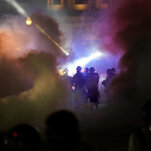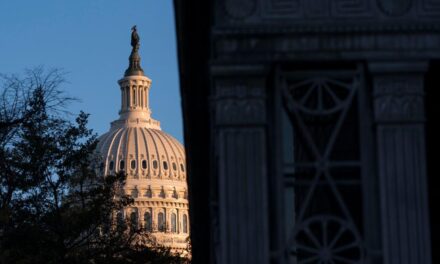
Kenosha, the Rittenhouse Verdict, and the Riots of 2020

Guest Essay

By Nancy Rommelmann
Ms. Rommelmann is a journalist and the founder of Paloma Media. She reported on the protests and unrest in Portland, Ore., in 2020.
On Aug. 25, 2020, violence was exploding on the streets of Kenosha, Wis., two days after the police shooting of Jacob Blake. Anyone who had been paying attention since the killing of George Floyd by the police in Minneapolis on May 25 most likely had one of two reactions: “Why is this happening? It’s unjustifiable” or “Of course this is happening, it’s completely justifiable.”
The violence in Kenosha was part of a familiar pattern. In cities across America, amid the upswelling of peaceful protest against racism and police brutality there were repeated episodes of rioting, looting and vandalism. This pattern was polarizing: Each act of violence, each injured participant or bystander, further entrenched the conviction that something was very, very wrong with the other side.
I was at the time reporting from the streets of Portland, Ore., covering the nightly rampages over the course of five months: the burning of police stations and offices, the smashing of storefronts, the battling with forces the Trump administration had sent to protect the federal courthouse. It was an ecstatic experience for some of those young rioters, to be free after months of Covid sequestration, to be taking it to Mr. Trump’s goons and the police, to be, by their lights, able both to save the world and to experience a nightly spurt of relief.
But every morning the streets looked worse, the ideals for which the non-peaceful protesters believed they were fighting not any closer, in fact not in evidence at all. It was often broken glass and ashes, and the riots would happen for 100 nights running and on into 2021. More than once, I heard people refer to what was going on as Groundhog Night, and I wondered, more than once, if anything would shake them from their mission, such as it was. I also wondered when the media was going to do what I felt was our job to do: Report what we saw as clearly and calmly as we could, in order to give the public the information they needed to be informed, form their own opinions and make rational choices.
Along with many Americans, I watched coverage of the Kenosha riots on television. I experienced the cognitive dissonance others did, seeing the live CNN shot of a reporter standing before a conflagration while the chyron read, “Fiery but mostly peaceful protests after police shooting.” This mismatch mirrored my experience with how much of the news from Portland was being reported, which often sought to present the protesters as only on the defensive, rarely the instigators, as if pointing out any bad actors ran the risk of tarring the entire protest movement.
It was bold that CNN believed its viewers capable of covering one eye, so to speak, so that the picture made sense. But it was also unsurprising, given that the station was constructing that picture, choosing the images that helped confirm viewers’ convictions (just as Fox News did, with Sean Hannity telling viewers that Portland had “been ripped apart by a group of malicious so-called anarchists” and calling the city a “war zone”; Laura Ingraham peddling the theory that 2020s California wildfires had been set “intentionally” by people “including antifa” and using the riots as an election year cudgel, warning that under President Biden the “whole country” would “look like Portland”).
I found these tactical framings reprehensible. How could anyone in good conscience use the looting and burning of people’s livelihoods as fuel for their ideological fires? It made me wonder if those who framed the destruction to fit their own means understood they were supporting violence against the working class and, often, people of color; that by their explicit or tacit encouragement, they were as good as standing on the sidelines cheering as people’s lives were burned to the ground. And if it was OK to destroy property today, what would they be able to see their way past tomorrow?
I would almost immediately have a chance to find out. On Aug. 29, Aaron Danielson, a Trump supporter and member of the right-wing group Patriot Prayer, was shot dead after participating in a pro-Trump caravan on the streets of Portland. The man suspected of killing him, Michael Reinoehl, was an antifa supporter who claimed to have been acting in defense of himself and others. The story, predictably, became a Rorschach test, some on the left seeing it as evidence that, as a woman who’d never met Mr. Danielson shouted through a bullhorn: “Our community can hold its own without the police. We can take out the trash on our own.” She added that she was “not sad” that a “fascist died tonight,” deriding Mr. Danielson with an expletive.
Kate Brown, the governor of Oregon, tried to tighten security by fortifying the local police with nearby sheriff’s deputies and Oregon State Police troopers. But the sheriffs of Clackamas and Washington counties rejected the governor’s plan, taking pains to criticize Portland’s approach to crime as they did so.
After Mr. Reinoehl was killed by officers from a federally led fugitive task force on Sept. 3, there were attempts on the left to lionize him as a casualty of the fight for racial justice. The standoff, even with lives at risk, reified for me how spring-loaded people were for the other side to be at fault, how ready to refashion events into what could be seen as useful weaponry.
Kyle Rittenhouse says he went into the streets of Kenosha with the mission to protect property and people. His father and other relatives lived in Kenosha, he had worked as a lifeguard there, and had a military-style semiautomatic rifle stashed at the home of a friend’s stepfather. The night of Aug. 25, Mr. Rittenhouse, who was 17 at the time, carrying a first aid kit and the rifle, waded into the mayhem with hazy ideas of helping, maybe of heroics. He ended up killing two men and badly injuring another. That it went terribly wrong is inarguable.
Also inarguable is that many see Mr. Rittenhouse as symbolic of the very worst of the other side. There is no hope of consensus regarding what happened in Kenosha on Aug. 25, 2020. There are those who believe that Mr. Rittenhouse’s actions were sensible or even laudable — the city had descended into lawlessness; the teenager, however benightedly, believed that he could offer some semblance of protection. They are not going to convince those who see Mr. Rittenhouse as something else entirely — the embodiment of white privilege and the far-right thuggery it enables — that his acquittal last week is anything but proof of a justice system beyond redemption and a rationale for both protests and riots. As a young man not much older than Mr. Rittenhouse told me in Portland in July 2020: “We’ve tried for 20 years to do it another way. It hasn’t worked. Nothing changes except with violence.”
If there is any hope that last week’s not-guilty verdict might do any good, might bridge the divide so many seem to prize and which every day gets an assist from the press, it is that we realize we need not continue this battle, that we can make Mr. Rittenhouse the last example of this particular war. Some on the right have sought to valorize Mr. Rittenhouse with in-your-face theatrics. Yet there has been little to no violence since the verdict; protests in Kenosha have been peaceful. I hope that this might be the moment we admit that our fear of the other birthed the events we claim to despise, that we created them and they have brought misery, and that we might now summon the courage and curiosity to look toward one another and say, we see how this happened, what can we make happen next?
Nancy Rommelmann (@NancyRomm) is a journalist and the founder of Paloma Media. She is the author, most recently, of “To the Bridge: A True Story of Motherhood and Murder.”
The Times is committed to publishing a diversity of letters to the editor. We’d like to hear what you think about this or any of our articles. Here are some tips. And here’s our email: [email protected].
Follow The New York Times Opinion section on Facebook, Twitter (@NYTopinion) and Instagram.
Source: https://www.nytimes.com/2021/11/22/opinion/politics/kenosha-rittenhouse-2020-protests.html

















